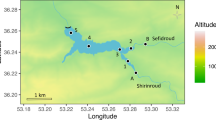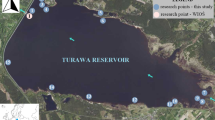Abstract
We evaluated 4-year-old data set to assess the trophic state and the controlling factors of the TGR during different experimental impounding (January 2005 to December 2005, stage I–stage II; January 2007 to December 2007, stage II–stage III; January 2009 to December 2009, stage III–stage IV) and normal operating (January 2011 to December 2011, stage IV) periods. The trophic state indices (TSITP) increased in the study area after TGR impoundment, and the TSISD and TSICHL did not significantly change after TGR impoundment; the values of TSICHL only increased at S1 (upstream sampling sites) after the TGR impoundment. The TSISD values in the Daning River (S1, S2, and S3) and the main stream of the TGR (S4) showed similar seasonal variations, with the highest values observed in the flood seasons, followed by the normal seasons and the dry seasons in descending order. The TSICHL only values varied substantially among the three seasons in the backwater area of the Daning River (S2), with the highest value occurring in the flood seasons, followed by dry seasons and normal seasons. The differences in the trophic state indices became smaller between the three seasons after TGR impoundment. The values of TSITP and TSISD showed similar spatial variances, with the highest value observed at S4, followed by S3, S2, and S1 in descending order. The TSICHL values were higher at S2 than at S3, S1, and S4. The results showed that the phosphorus and nonalgal turbidity limit trophic status of the mainstream of TGR and Daning River before and after experimental impoundment.





Similar content being viewed by others
References
Burford MA, Johnson SA, Cook AJ, Packer TV, Taylor BM, Townsley ER (2007) Correlations between watershed and reservoir characteristics, and algal blooms in subtropical reservoirs. Water Res 41:4105–4114. doi:10.1016/j.watres.2007.05.053
Cao C, Zheng B, Chen Z, Huang M, Zhang J (2011) Eutrophication and algal blooms in channel type reservoirs: a novel enclosure experiment by changing light intensity. J Environ Sci 23:1660–1670. doi:10.1016/S1001-0742(10)60587-6
Carlson RE (1977) A trophic state index for lakes. Limnol Oceangr 22:361–369. doi:10.4319/lo.1977.22.2.0361
Carlson RE (1991) Expanding the trophic state concept to identify non-nutrient limited lakes and reservoirs. In: Proceedings of a national conference on enhancing the states’ lake management programs, monitoring and lake impact assessment. North American Lake Management Society, Madison, pp 59–71
Chinese Research Academy of Environmental Sciences (CRAES) (2004) Studies report on the assessment standards and methods for Trophic status in the three Gorge Reservoir. (in Chinese)
Dillon PJ, Rigler FH (1974) A test of a simple nutrient budget model predicting the phosphorus concentration in lake water. J Fish Res Board Can 31:1771–1778. doi:10.1139/f74-225
Duan H, Ma R, Xu X, Kong F, Zhang S, Kong W, Hao J, Shang L (2009) Two-decade reconstruction of algal blooms in China’s lake Taihu. Environ Sci Technol 43:3522–3528. doi:10.1021/es8031852
Frutiger A (2004) Ecological impacts of hydroelectric power production on the river Ticino. Part 1: thermal effects. Arch Hydrobiol 159:43–56. doi:10.1127/0003-9136/2004/0159-0043
George DG, Hurley MA (2003) Using a continuous function for residence time to quantify the impact of climate change on the dynamics of thermally stratified lakes. J Limnol 62:21–26. doi:10.4081/jlimnol.2003.s1.21
Glenn BM, Larelle DF (2008) Dominance of Cylindrospermopsis raciborskii (Nostocales, Cyanoprokaryota) in Queensland tropical and subtropical reservoirs: implications for monitoring and management. Lakes Reserv: Res Manag 5:195–205
Guo L (2007) Doing battle with the green monster of Taihu Lake. Science 317:1166. doi:10.1126/science.317.5842.1166
Haven KE (2000) Using trophic state index (TSI) values to draw inferences regarding phytoplankton limiting factors and seston composition from routine water quality monitoring data. Korean J Limnol 33:187–196
Humborg C, Ittekkot V, Cociasu A, Bv Bodungen (1997) Effect of Danube River dam on Black sea biogeochemistry and ecosystem structure. Nature 386:385–388. doi:10.1038/386385a0
Jones ID, Elliott JA (2007) Modelling the effects of changing retention time on abundance and composition of phytoplankton species in a small lake. Freshw Biol 52:988–997. doi:10.1111/j.1365-2427.2007.01746.x
Jones GJ, Poplawski W (1998) Understanding and management of Cyanobacterial blooms in sub-tropical reservoirs of Queensland, Australia. Water Sci Technol 37:161–168. doi:10.1016/S0273-1223(98)00020-1
Kawara O, Yura E, Fujii S, Matsumoto T (1998) A study on the role of hydraulic retention time in eutrophication of the Asahi river Dam reservoir. Water Sci Technol 37:245–252. doi:10.1016/S0273-1223(98)00030-4
Lawrence I, Bormans M, Oliver R (2000) Physical and nutrient factors controlling algal succession and biomass in Burrinjuck Reservoir. Technical Report, Cooperative Research Centre for Freshwater Ecology
Lehman JT, Platte RA, Ferris JA (2007) Role of hydrology in development of a vernal clear water phase in an urban impoundment. Freshw Biol 52:1773–1781. doi:10.1111/j.1365-2427.2007.01808.x
Ryding S, Rast W (1989) Control of eutrophication of lakes and reservoirs. Parthenon Publishing, Park Ridge
Schindler DW (2006) Recent advances in the understanding and management of eutrophication. Limnol Oceanogr 51:356–363
SEPA (2002) Standard methods for the examination of water and wastewater. Chinese Entironment Science Press, Beijing (in Chinese)
Shen Z, Hong Q, Yu H, Liu R (2008) Parameter uncertainty analysis of the non-point source pollution in the Daning River watershed of the three Gorges reservoir region, China. Sci Total Environ 405:195–205. doi:10.1016/j.scitotenv.2008.06.009
Strain PM, Yeats PA (1999) The relationships between chemical measures and potential predictors of the eutrophication status of inlets. Mar Pollut Bull 38:1163–1170. doi:10.1016/S0025-326X(99)00151-4
Straškraba M, Tundisi JG (1999) Reservoir water quality management. International Lake Environment Foundation, Kusatsu
Tarczyńska M, Romanowska-Duda Z, Jurczak T, Zalewski M (2001) Toxic cyanobacterial blooms in a drinking water reservoir—causes, consequences and management strategy. Water Sci Technol Water (Supply) 1:237–246
Vannote RL, Minshall GW, Cumminus KW, Sedell JR, Cushing CE (1980) The river continuum concept. Can J Fish Aquat Sci 37:130–137
Ward JV, Stanford JA (eds) (1979) The ecology of regulated streams. Plennum Press, New York
White GF (1988) The environmental effects of the high dam at Aswan. Environ Sci Policy Sustain Dev 30:4–40. doi:10.1080/00139157.1988.9930898
Xu Y, Shao M, Cao M, Zhou S, Cai Q (2010a) Using temporal coherence to determine the responses of water clarity to hydrological processes in a giant subtropical canyon-shaped reservoir (China). Quat Int 226:151–159. doi:10.1016/j.quaint.2009.08.013
Xu Y, Cai Q, Han X, Shao M, Liu R (2010b) Factors regulating trophic status in a large subtropical reservoir. China. Environ Monit Assess 169:237–248. doi:10.1007/s10661-009-1165-5
Xu Y, Shao M, Han X, Cai Q (2011a) Temporal asynchrony of trophic status between mainstream and Tributary Bay within a Giant dendritic reservoir: the role of local-scale regulators. Water Air Soil Pollut 219:271–284. doi:10.1007/s11270-010-0705-5
Xu Y, Zhang M, Wang L, Kong L, Cai Q (2011b) Changes in water types under the regulated mode of water level in Three Gorges reservoir, China. Quat Int 244:272–279. doi:10.1016/j.quaint.2011.01.019
Xu Y, Schroth AW, Rizzo DM (2015) Developing a 21st Century framework for lake-specific eutrophication assessment using quantile regression. Limnol Oceanogr: Methods 13:237–249. doi:10.1002/lom3.10021
Yan Q, Yu Y, Feng W, Yu Z, Chen H (2008) Plankton community composition in the Three Gorges Reservoir region revealed by PCR-DGGE and its relationships with environmental factors. J Environ Sci 20:732–738. doi:10.1016/S1001-0742(08)62120-8
Yang Z, Liu D, Ji D, Xiao S (2010) Influence of the impounding process of the three Gorges reservoir up to water level 172.5 m on water eutrophication in the Xiangxi Bay. Sci China Technol Sci 53:1114–1125. doi:10.1007/s11431-009-0387-7
Yang L, Liu D, Huang Y, Yang Z, Ji D, Song L (2015) Isotope analysis of the nutrient supply in Xiangxi Bay of the Three Gorges Reservoir. Ecol Eng 77(2015):65–73. doi:10.1016/j.ecoleng.2015.01.013
Young K, Morse GK, Scrimshaw MD, Kinniburgh JH, MacLeod CL, Lester JN (1999) The relation between phosphorus and eutrophication in the Thames catchment, UK. Sci Total Environ 228:157–183. doi:10.1016/S0048-9697(99)00043-1
Zeng H, Song L, Yu Z, Chen H (2006) Distribution of phytoplankton in the Three-Gorge Reservoir during rainy and dry seasons. Sci Total Environ 367:999–1009. doi:10.1016/j.scitotenv.2006.03.001
Zhang J-L, Zheng B-H, Liu L-S, Wang LJ, Huang M, Wu GY (2010) Seasonal variation of phytoplankton in the Daning River and its relationships with environmental factors after impounding of the three Gorges reservoir: a four-year study. Proc Environ Sci 2:1479–1490. doi:10.1016/j.proenv.2010.10.161
Zhang J-L, Zheng B-H, Liu L-S, Wang LJ, Wu GY (2012) Comparison of trophic status analysis of the Daning River within the Three Gorges Reservoir before and after experimental impoundment. Huan Jing Ke Xue 33:3382–3389 (in Chinese)
Zheng B-H, Zhang Y, Fu G, Liu H (2006) On the assessment standards for nutrition status in the Three Gorge Reservoir. Acta Sci Circumst 26:1022–1030 (in Chinese)
Zhong C-H, Xing Z-G, Zhao W-Q, Wang D, Deng C-G, Li Y-J et al (2004) Eutrophication investigation and assessment of the Daning River after water storage of the Three Gorges Reservoir. Chin J Geochem 24:149–154
Acknowledgments
The authors would like to thank the following agencies for supporting our work: the National Natural Science Foundation of China (51209190, 41401586), the International Science and Technology Cooperation Program of China (2014DFE70070), the National Basic Research Program of China (2014CB460601), and the National Science and Technology Major Project (2014ZX07104-006-001).
Author information
Authors and Affiliations
Corresponding author
Additional information
Jia-Lei Zhang and Li-Jing Wang have contributed equally to this study as first co-authors.
This article is part of a Topical Collection in Environmental Earth Sciences on “Environmental Research of the Three Gorges Reservoir”.
Guest edited by Binghui Zheng, Shengrui Wang, Yanwen Qin, Stefan Norra, and Xiafu Liu.
Rights and permissions
About this article
Cite this article
Zhang, JL., Wang, LJ., Zheng, BH. et al. Eutrophication status of the Daning River within the Three Gorges Reservoir and its controlling factors before and after experimental impoundment. Environ Earth Sci 75, 1182 (2016). https://doi.org/10.1007/s12665-016-5931-8
Received:
Accepted:
Published:
DOI: https://doi.org/10.1007/s12665-016-5931-8




